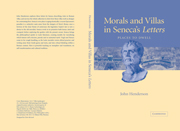Book contents
- Frontmatter
- Contents
- Acknowledgements
- Introduction
- 1 Twelve steps to haven
- 2 Dropping in (it) at SENECA'S
- 3 You can get used to anything
- 4 The long and winding mode
- 5 Booking us in
- 6 Now and then; here and there: at SCIPIO'S
- 7 Bound for VATIA'S
- 8 Knocking the self: genuflexion, villafication, VATIA'S
- 9 The world of the bath-house: SCIPIO'S
- 10 The appliance of science: SCIPIO'S
- 11 Shafts of light: transplantation and transfiguration
- 12 Still olive, still SCIPIO'S
- Appendix 1 Here to stay Places and persons named in the Epistulae Morales
- Appendix 2 From: Letter 86 To: A Dying Light in Corduba
- Bibliography
- Indexes
- References
Bibliography
Published online by Cambridge University Press: 22 September 2009
- Frontmatter
- Contents
- Acknowledgements
- Introduction
- 1 Twelve steps to haven
- 2 Dropping in (it) at SENECA'S
- 3 You can get used to anything
- 4 The long and winding mode
- 5 Booking us in
- 6 Now and then; here and there: at SCIPIO'S
- 7 Bound for VATIA'S
- 8 Knocking the self: genuflexion, villafication, VATIA'S
- 9 The world of the bath-house: SCIPIO'S
- 10 The appliance of science: SCIPIO'S
- 11 Shafts of light: transplantation and transfiguration
- 12 Still olive, still SCIPIO'S
- Appendix 1 Here to stay Places and persons named in the Epistulae Morales
- Appendix 2 From: Letter 86 To: A Dying Light in Corduba
- Bibliography
- Indexes
- References
- Type
- Chapter
- Information
- Morals and Villas in Seneca's LettersPlaces to Dwell, pp. 177 - 183Publisher: Cambridge University PressPrint publication year: 2004



